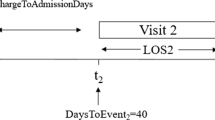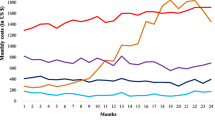Abstract
Healthcare spending has been increasing in the last few decades. This increase can be attributed to hospital readmissions, which is defined as a re-hospitalization of a patient after being discharged from a hospital within a short period of time. The correct selection of the primary medical procedure by physicians is the first step in the patient treatment process and is considered to be of the main causes for hospital readmissions. In this paper, we propose a recommender system that can accurately predict the primary medical procedure for a new admitted patient, given his or her set of diagnoses. The core of the recommender system relies on identifying other existing patients that are considered similar to the new patient. That said, we propose three approaches to predict the primary procedure. The results show the ability of our proposed system to identify the primary procedure. It can be later used to build a graph which shows all possible paths that a patient may undertake during the course of treatment.
Access this chapter
Tax calculation will be finalised at checkout
Purchases are for personal use only
Similar content being viewed by others
References
Goodman, J.C.: Priceless: Curing the Healthcare Crisis. Independent Institute, Oakland (2012)
Keehan, S.P., et al.: National health expenditure projections, 2014–24: spending growth faster than recent trends. Health Aff. 34(8), 1407–1417 (2015)
Price Waterhouse Coopers: The Price of Excess. Identifying Waste in Healthcare Spending. Price Waterhouse Coopers Research Institute, London (2006)
Touati, H., Raś, Z.W., Studnicki, J., Wieczorkowska, A.A.: Mining surgical meta-actions effects with variable diagnoses’ number. In: Andreasen, T., Christiansen, H., Cubero, J.-C., Raś, Z.W. (eds.) ISMIS 2014. LNCS, vol. 8502, pp. 254–263. Springer, Cham (2014). doi:10.1007/978-3-319-08326-1_26
Lally, A., Bachi, S., Barborak, M.A., Buchanan, D.W., Chu-Carroll, J., Ferrucci, D.A., Glass, M.R., Kalyanpur, A., Mueller, E.T., Murdock, J.W., Patwardhan, S.: WatsonPaths: scenario-based question answering and inference over unstructured information. Technical report, Research report RC25489, IBM Research (2014)
Tremblay, M.C., Berndt, D.J., Studnicki, J.: Feature selection for predicting surgical outcomes. In: Proceedings of 39th Annual Hawaii International Conference on System Sciences, HICSS 2006, vol. 5, p. 93a. IEEE (2006)
Silow-Carroll, S., Edwards, J.N., Lashbrook, A.: Reducing hospital readmissions: lessons from top-performing hospitals. CareManagement 17(5), 14 (2011)
Miotto, R., Li, L., Kidd, B.A., Dudley, J.T.: Deep patient: an unsupervised representation to predict the future of patients from the electronic health records. Scientific reports 6 (2016)
Almardini, M., Hajja, A., Raś, Z.W., Clover, L., Olaleye, D., Park, Y., Paulson, J., Xiao, Y.: Reduction of readmissions to hospitals based on actionable knowledge discovery and personalization. In: Kozielski, S., Mrozek, D., Kasprowski, P., Małysiak-Mrozek, B., Kostrzewa, D. (eds.) BDAS 2015-2016. CCIS, vol. 613, pp. 39–55. Springer, Cham (2016). doi:10.1007/978-3-319-34099-9_3
Almardini, M., Hajja, A., Clover, L., Olaleye, D., Park, Y., Paulson, J., Xiao, Y.: Reduction of hospital readmissions through clustering based actionable knowledge mining. In: Proceedings of IEEE/WIC/ACM International Conference on Web Intelligence (WI 2016), pp. 444–448. IEEE Computer Society (2016)
Healthcare Cost and Utilization Project (HCUP). Clinical classifications software (ccs). http://www.hcup-us.ahrq.gov
Acknowledgment
This work was supported by SAS Institute under UNC-Charlotte Internal Grant No. 15-0645.
Author information
Authors and Affiliations
Corresponding author
Editor information
Editors and Affiliations
Rights and permissions
Copyright information
© 2017 Springer International Publishing AG
About this paper
Cite this paper
Almardini, M., Hajja, A., Raś, Z.W., Clover, L., Olaleye, D. (2017). Predicting the Primary Medical Procedure Through Clustering of Patients’ Diagnoses. In: Appice, A., Ceci, M., Loglisci, C., Masciari, E., Raś, Z. (eds) New Frontiers in Mining Complex Patterns. NFMCP 2016. Lecture Notes in Computer Science(), vol 10312. Springer, Cham. https://doi.org/10.1007/978-3-319-61461-8_8
Download citation
DOI: https://doi.org/10.1007/978-3-319-61461-8_8
Published:
Publisher Name: Springer, Cham
Print ISBN: 978-3-319-61460-1
Online ISBN: 978-3-319-61461-8
eBook Packages: Computer ScienceComputer Science (R0)




